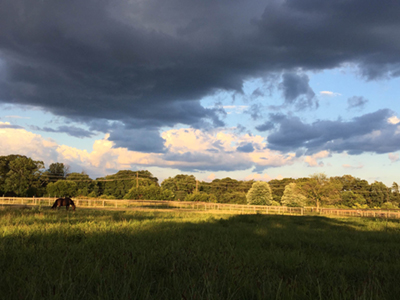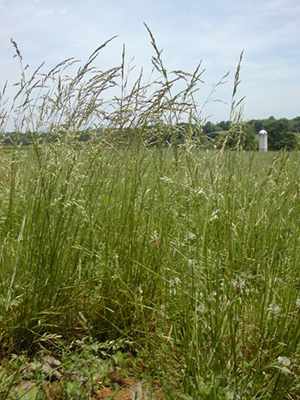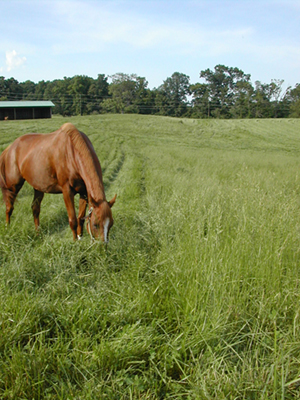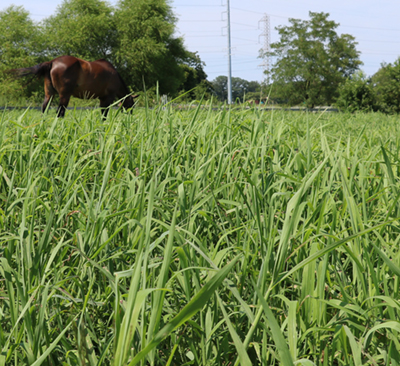Fact Sheet FS1340
Non-structural carbohydrates in equine feedstuffs are of concern for horse owners, particularly those managing horses that are obese or have a history of insulin resistance and/or pasture-associated laminitis. Limiting non-structural carbohydrate intake is a key component of nutritional management for these horses. This can be challenging for owners wishing to maintain their horses on pasture forage, hence there is a need to identify pasture forages that are lower in non-structural carbohydrates and less preferred by grazing horses.
What are Non-structural Carbohydrates?
Non-structural carbohydrates (NSC) consist of fructans, sugars, and starches produced and stored within growing plants. Sugars, including monosaccharides such as glucose and fructose as well as disaccharides such as sucrose, are designated as ethanol-soluble carbohydrates (ESC), and are the largest portion of NSC in most forages. Water-soluble carbohydrates (WSC) include the ESC sugars and longer, more complex chains of sugars called fructans. The NSC concentration of feeds includes both WSC and starch (which is not included in either the ESC or WSC fractions).
The NSC in feedstuffs is broken down within the equine gastrointestinal system, providing energy to support maintenance requirements of adult horses along with additional energy for those that are undergoing exercise, growth, or reproduction. Starch and sugars are primarily digested and absorbed in the horse's small intestine, resulting in increased blood glucose and insulin levels. Mammals, including horses, do not possess the digestive enzymes necessary for breakdown of fructans, which thus pass to the hindgut and are subject to fermentation by the microbiota in the cecum and large colon. Byproducts of bacterial fermentation can then be absorbed and used for additional energy by the horse.
Factors Impacting Pasture Forage Non-structural Carbohydrates
There are many factors that impact the concentration of NSC in pastures including the forage species and variety within species, time of day, seasonal growth patterns, and plant maturity as well as various environmental and management factors.
Species
Warm-season grasses (e.g. bermudagrass, teff, crabgrass) and legumes (e.g. alfalfa and clover) tend to be lower in NSC than cool-season grasses (e.g. orchardgrass, tall fescue, Kentucky bluegrass) of similar maturity, but variation in NSC exists within these forage types. For example, perennial ryegrass is often higher in NSC than other cool-season grass species (see below for more details).

Figure 1. A horse eating in a shady pasture, early in the morning when NSC would be at its lowest. Image courtesy of C. Williams.
Time of Day
Forage NSC is known to be highest in the late afternoon and early evening (approximately 4:00 to 8:00 p.m.) as sugars produced by photosynthesis accumulate in plants throughout the day; NSC is lowest in early morning hours (approximately 4:00 to 8:00 a.m.) when the sugars have been depleted by plant processes including growth in the hours when the sun is down. It should be noted that colder temperatures can alter these diurnal patterns in NSC concentrations.
Seasonality
The NSC in cool-season grasses are highest in the spring and lowest in the summer, with a subsequent rise in NSC documented during fall months until grasses enter winter dormancy. The NSC also decreases from first grazing in mid-summer through late summer and early fall for warm-season grasses.

Figure 2. A cool-season grass pasture that has gone to seed would be lower in total NSC, but higher in starch. Image courtesy of C. Williams.
Plant Maturity
Sugars decrease as plants become more mature. As mature plants develop seed heads, starch concentrations increase. Peak starch concentrations are typically much lower than peak sugar concentrations, and therefore overall NSC also declines as plants mature. Forage NSC can, however, fluctuate due to environmental stressors regardless of plant maturity (see Environment).
Environment
Climatic conditions such as intensity of sunlight, temperature, and precipitation can affect NSC concentrations. For example, cloudy days result in lower NSC as there is less sunlight available to drive photosynthesis and thus sugar production in plants. Cooler temperatures can result in accumulation of sugars as energy stores are retained for future use under warmer conditions. Increased sugar concentrations in response to cold stress also serve as an adaptation that lowers the internal freezing temperature within the plant, protecting grasses as temperatures drop near freezing. Heat and drought stress may also cause short-term increases in NSC as photosynthesis continues while growth is limited. However, when prolonged, these stressors can lower NSC concentrations due to lower rates of photosynthesis under these conditions.

Figure 3. A horse eating a pasture that has been partially mowed and partially not; these two parts of the field would have different NSC content. Image courtesy of C. Williams.
Management
Management practices including frequency and height of forage removal by mowing and/or grazing influence NSC concentrations. For example, Siciliano et al. (2017) found that NSC concentrations were lower in pastures mowed to 6 inches vs. un-mowed pastures at 16 inches. Overgrazing can also impact pasture NSC. Plants, particularly perennial cool-season grasses, do store soluble carbohydrates in the bases of stems, which could expose horses maintained on overgrazed pastures to parts of plants which may be higher in NSC. However, defoliated plants have minimal leaf material to support photosynthetic activity and translocate NSC to stores below ground (i.e. roots) as a protective survival response. These stores (and those in any remaining leaf material) are then utilized as the plant attempts to regrow. Therefore, overall sugars in the parts of the plant above ground are limited. Recent studies comparing nutrient composition of overgrazed continuous horse pastures and rotational pastures managed according to recommended best management practices found no difference in NSC (Williams et al. 2019; 2020). It is important to note that differences in NSC-based management practices that affect pasture forage height are distinct from comparisons of short, immature growing plants versus taller, mature pastures (see Plant Maturity above). Additionally, fertilization can also impact pasture NSC concentrations. For example, a deficit of nitrogen in soils often results in lower NSC concentrations in growing plants.
Non-structural Carbohydrates and Grazing Horses
Intake of NSC from pasture forage is of concern in nutritional management of certain grazing horses. Circulating blood glucose and insulin are influenced by the NSC concentrations of feedstuffs – both of concentrates and forages – with higher NSC resulting in elevated glucose and insulin. Thus, higher NSC in pasture forages could exacerbate hyperinsulinemia in insulin resistant horses beyond a threshold that could trigger laminitic episodes in these at-risk grazing horses. Therefore, feedstuffs with NSC concentrations of <10–12% are recommended for obese horses and horses with a history of metabolic dysfunction.
Furthermore, horses provided ad libitum access to pasture often consume pasture forage well above what is needed to meet nutritional requirements. Over-consumption of pasture forage can lead to excess NSC intake as well as weight gain, which can in turn have negative impacts on equine metabolic health.
Several strategies are available to horse owners wishing to limit NSC intake from pasture forage. These include limiting the duration of grazing time each day, confining grazing to early morning hours when NSC concentrations of pasture grasses are known to be lower, utilizing grazing muzzles, and grazing grass species that are less preferred and/or lower in NSC.

Figure 4. Mixed cool-season grasses including Kentucky bluegrass, orchardgrass, and tall fescue. Image courtesy of K. Hartmann.
Cool-season vs. Warm-season Grasses
Pasture forages in temperate regions of the United States are mainly perennial cool-season grasses such as orchardgrass [Dactylis glomerata (L.)], tall fescue [Lolium arundinaceum (Schreb.) Darbysh.], Kentucky bluegrass [Poa pratensis (L.)], timothy [Phleum pratense (L.)], and perennial ryegrass [L. perenne (L.)]. Cool-season grasses accumulate sugars and fructans, particularly during periods of cooler temperatures. There is a relatively high capacity for synthesis and storage of fructan in plant cell vacuoles, as these stores increase during times of active photosynthesis and limited growth.
Warm-season grasses such as bermudagrass [Cynodon dactylon (L.) Pers.], crabgrass [Digitaria sanguinalis (L.) Scop.], sudangrass [Sorghum bicolor (L.) Moench spp. drummondii], sorghum-sudangrass [S. bicolor (L.) x S. bicolor var. sudanense], pearl millet [Pennisetum glaucum (L.) R. Br.], and teff [Eragrostis tef (L.)] are more commonly grown in warmer climates of the

Figure 5. Quick-N-Big crabgrass, a warm-season annual grass. Image courtesy of K. Hartmann.
southern United States. Warm-season grasses do not produce fructan. Rather, warm-season grasses rely on sugars and starch as a form of storage carbohydrate, although sugars are typically also found in lower concentration in warm-season vs. cool-season grasses. Starch accumulation, however, is generally greater in warm-season grasses.
Overall, these differences in carbohydrate storage mechanisms result in greater ESC, WSC, and NSC in cool-season grasses in comparison to warm-season grasses. Thus, warm-season grasses have been suggested as alternative pasture forages for horses in which NSC intake is of concern. It is not guaranteed that warm-season grasses will always be below the recommended NSC level for at-risk horses.
Warm-season Grasses as Equine Pasture Forages
Suitability for equine grazing is of concern for many warm-season grasses. Many warm-season grasses such as sorghum and switchgrass commonly utilized in cattle grazing systems produce compounds including prussic acids, saponins, and/or oxalates that can be toxic for horses. Additionally, most traditionally cultivated warm-season perennial grasses commonly grown in the Southern U.S. are cold-sensitive and cannot survive winters in cooler temperate regions. These factors may limit use of warm-season grasses in temperate horse grazing systems.
However, several studies in the mid-Atlantic and upper-Midwest have evaluated the NSC content in warm-season grasses. Studies of warm-season perennial grasses have confirmed that these forages do have relatively low concentrations of NSC. Jaqueth et al. (2021) reported that NSC concentrations averaged below 10% for zoysiagrass (Compadre and Zenith varieties), while NSC concentrations in the cold-tolerant bermudagrass turf-type varieties Yukon and Riviera as well as Common bermudagrass were more variable and exceeded 12% depending upon the month of sampling and the year in which forages were evaluated. Ghajar et al. (2021) assessed the native warm-season grasses indiangrass, gammagrass, and big bluestem as potential horse pasture forages, finding NSC concentrations ranging from 8.3–12.4%.
Warm-season annuals investigated for use as equine pasture forages have also been found to be low in NSC. DeBoer et al. (2017) analyzed nutrient composition of Japanese millet, Siberian millet, teff, sorghum sudangrass brown midrib, and sudangrass. The NSC content for all warm-season annuals was under 12% and was consistently lower in comparison to annual ryegrass, a cool-season species. Jaqueth et al. (2021) found NSC concentrations of 11–13% in an improved forage crabgrass variety, Red River. Similarly, Weinert-Nelson et al. (2021a) reported NSC concentrations under 10% for Quick-N-Big crabgrass horse pastures but found minimal differences with cool-season horse pastures in which NSC also remained below 10% during the months of July through October. However, Weinert-Nelson et al. (2021b) found that NSC was greater in cool-season grasses (18%) in comparison to both Quick-N-Big crabgrass and cold-tolerant Wrangler bermudagrass (both about 11%) when pastures were evaluated at a similar stage of maturity (boot stage) rather than on the same calendar date.
Horses may also exhibit a lesser preference for warm-season grasses. DeBoer et al. (2017) found that annual ryegrass was consistently preferred over most warm-season annual varieties, but a high percent removal was also reported for teff. Among warm-season annual grasses, Siberian millet was least preferred. Weinert-Nelson (2021) found that grazing horses had lesser preference for Quick-N-Big crabgrass in comparison to mixed cool-season grass. This may be beneficial for horses that typically overconsume the more common cool-season pasture forages. For more on warm-season grasses (crabgrass) for use in New Jersey see FS1339, Crabgrass Integration in New Jersey Horse Pastures.
Overall Conclusions and Recommendations
Warm-season annual and perennial grasses can provide a low-NSC source of pasture forage. However, NSC concentrations in pasture forage are heavily dependent on environmental and management conditions and can vary between species and even between varieties within species. Submitting pasture samples for nutrient analysis can confirm if NSC concentrations are below recommended levels for horses in which NSC intake is of concern (for more on forage analysis see FS714, Analysis of Feeds and Forages for Horses).
References and Additional Reading
- Belesky, D. P., S. R. Wilkinson, and J. A. Stuedemann. 1991. The influence of nitrogen fertilizer and Acremonium coenophialum on soluble carbohydrate content of grazed and non-grazed Festuca arundinace. Grass Forage Sci. 46:159-166. doi: 10.1111/j.1365-2494.1991.tb02218.x
- DeBoer, M. L., C. C. Sheaffer, A. M. Grev, D. N. Catalano, M. S. Wells, M. R. Hathaway, and K. L. Martinson. 2017. Yield, nutritive value, and preference of annual warm‐season grasses grazed by horses. Agron. J. 109.5:2136-2148. doi: 10.2134/agronj2017.02.0099
- Durham, A. E., N. Frank, C. M. McGowan, N. J. Menzies‐Gow, E. Roelfsema, I. Vervuert, K. Feige, and K. Fey. 2019. ECEIM consensus statement on equine metabolic syndrome. J. Vet Intern. Med. 33.2:335-349. doi: 10.1111/jvim.15423
- Ghajar, S. M., H. McKenzie, J. Fike, B. McIntosh, and B. F. Tracy. 2021. Evaluating digestibility and toxicity of native warm-season grasses for equines. Transl. Anim. Sci. 5.1:txaa224. doi: 10.1093/tas/txaa224
- Jaqueth, A.L., T.R. Turner, M.E. Iwaniuk, B.J. McIntosh, and A.O. Burk. 2021. Relative traffic tolerance of warm-season grasses and suitability for grazing by equine. J. Equine Vet. Sci. 103:103244. doi: 10.1016/j.jevs.2020.103244
- Jensen, K.B., P. Harrison, N.J. Chatterton, B.S. Bushman, and J.E. Creech. 2014. Seasonal trends in nonstructural carbohydrates in cool‐and warm‐season grasses. Crop Sci. 54.5:2328-2340. doi: 10.2135/cropsci2013.07.0465
- Siciliano, P. D., J. C. Gill, and M. A. Bowman. 2017. Effect of sward height on pasture nonstructural carbohydrate concentrations and blood glucose/insulin profiles in grazing horses. J Equine Vet. Sci. 57:29-34. doi: 10.1016/j.jevs.2017.06.004
- Teutsch, C. 2006. Warm-season annual grasses for summer forage. Publication 418-004. Communication and Marketing, College of Agriculture and Life Sciences, Virginia Polytechnic Inst. and State Univ., Blacksburg, VA.
- Weinert-Nelson, J.R. 2021. Integrated warm- and cool-season grass equine rotational grazing systems: pasture production, grazing behavior, metabolism, and the gut microbiome. Diss. Rutgers, The State University of New Jersey, New Brunswick, NJ.
- Weinert-Nelson, J.R., W.A. Meyer, and C.A. Williams. 2021a. Yield, nutrient composition, and horse condition in integrated crabgrass and cool-season grass rotational grazing pasture systems. Transl. Anim. Sci. 5:1-18. doi: 10.1093/tas/txab208
- Weinert-Nelson, J.R., W.A. Meyer, and C.A. Williams. 2021b. Diurnal Variation in Forage Nutrient Composition of Mixed Cool-Season Grass, Crabgrass, and Bermudagrass Pasture Forage. J. Equine Vet Sci. 110:1-6. doi: 10.1016/j.jevs.2021.103836.
- Williams, C. A., L. B. Kenny, and A. O. Burk. 2019. Effects of grazing system, season, and forage carbohydrates on glucose and insulin dynamics of the grazing horse. J. Anim. Sci. 97:2541–2554. doi: 10.1093/jas/skz103
- Williams, C. A., L. B. Kenny, J. R. Weinert, K. Sullivan, W. Meyer, and M. G. Robson. 2020. Effects of 27 mo of rotational vs. continuous grazing on horse and pasture condition. Transl. Anim. Sci. 4:1-17. doi: 10.1093/tas/txaa084
February 2022
Copyright © 2025 Rutgers, The State University of New Jersey. All rights reserved.
For more information: njaes.rutgers.edu.
Cooperating Agencies: Rutgers, The State University of New Jersey, U.S. Department of Agriculture, and Boards of County Commissioners. Rutgers Cooperative Extension, a unit of the Rutgers New Jersey Agricultural Experiment Station, is an equal opportunity program provider and employer.

